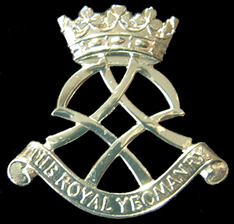Related Research Articles
This is the Operation Telic order of battle, which lists the British forces that took part in Operation Telic, including

The Royal Corps of Signals is one of the combat support arms of the British Army. Signals units are among the first into action, providing the battlefield communications and information systems essential to all operations. Royal Signals units provide the full telecommunications infrastructure for the Army wherever they operate in the world. The Corps has its own engineers, logistics experts and systems operators to run radio and area networks in the field. It is responsible for installing, maintaining and operating all types of telecommunications equipment and information systems, providing command support to commanders and their headquarters, and conducting electronic warfare against enemy communications.
Options for Change was a restructuring of the British Armed Forces in summer 1990 after the end of the Cold War.

The Royal Yeomanry (RY) is the senior reserve light cavalry regiment of the British Army. Equipped with Supacat Jackal variants, their role is to conduct mounted and dismounted formation reconnaissance. The Regimental Headquarters is located in Leicester, with squadrons in Fulham, Nottingham, Dudley, Croydon, Telford, and Leicester. The regiment is part of the Royal Armoured Corps and is paired with and supports the 1st The Queen's Dragoon Guards (QDG). QDG and RY together form the light cavalry reconnaissance component of 7th Infantry Brigade, serving alongside six infantry battalions. The Royal Yeomanry is the only British Army Reserve unit to have been awarded a battle honour since the Second World War.

The 33rd Signal Regiment was a British Territorial Army regiment of the Royal Corps of Signals.

The 44th Parachute Brigade (Volunteers) was a British Army Territorial Army parachute brigade, active from c.1950 to 1978.

The 2nd Signal Brigade, was a military formation of the British Army composed of Royal Corps of Signals units. The brigade was first formed following the reorganisation of the old Territorial Army in 1967, and was disbanded in 2012 under the Army 2020 programme. However, later the 2nd Signal Group was formed continuing the lineage of the old brigade, before it was disbanded in 2018.
71 Yeomanry Signal Regiment is an Army Reserve regiment in the Royal Corps of Signals in the British Army. The regiment forms part of 11th Signal Brigade, providing military communications for national operations.

The 31st Signal Regiment was a territorial communications regiment of the British Army's Royal Corps of Signals. The regiment first formed following the creation of the Territorial and Army Volunteer Reserve in 1967 after the 1966 Defence White Paper. After seeing limited reserve support during the Cold War, the regiment was disbanded in 2010 following the initial Army 2020 reform.

37th Signal Regiment is an Army Reserve regiment in the Royal Corps of Signals in the British Army. The regiment forms part of 11th Signal Brigade, providing military communications for national operations.
The Kensington Regiment is a unit of the British Army, which originated in the Volunteer Rifle Corps' movement of the 1850s. In 1908 it became a battalion of the London Regiment in the Territorial Force. It was an infantry regiment from 1908 to 1940, a heavy fire support unit from 1940 to 1945, and has been a unit of the Royal Corps of Signals since 1945.
Land Command was a military command and part of the structure of the British Army from 1995 to 2008. Its headquarters was at Erskine Barracks, at Fugglestone St Peter, some four kilometres northwest of Salisbury in Wiltshire.
In September 1939, the British Army was in process of expanding their anti-aircraft and mobile assets. Among these new changes was the formation of Anti-Aircraft Command which was formed on 1 April 1939, and the 1st Armoured Division formed in 1937. The list below will include the British Army units, colonial units, and those units which were in the process of formation.

The 2nd Anti-Aircraft Division was an Air Defence formation of the British Army from 1935 to 1942. It controlled anti-aircraft gun and searchlight units of the Territorial Army (TA) defending the East Midlands and East Anglia during The Blitz.
London District Signals was a headquarters signal unit of the Royal Engineers (RE) and later Royal Corps of Signals in Britain's Territorial Army from 1908. It served with a corps headquarters at Gallipoli and on the Western Front during World War I, and later became an air defence signal unit during World War II. Its successor unit continues in the Army Reserve today.
The 13th Signals Group was a military communications brigade sized formation of the British Army. The group was established in 1967 to control the territorial signals regiments with national communication duties in the United Kingdom. It was later disbanded in 1974, when it merged with the 2nd Signal Group.
The 7th Battalion, The Rifles is an Army Reserve battalion of the British Army originally formed in 1999 as an independent regiment, however later became part of The Rifles following the Future Army Structure programme, and remains an integral part of the regiment.

The 4th (Volunteer) Battalion, The Worcestershire and Sherwood Foresters was a former territorial infantry battalion that existed for a short time towards the end of the Cold War. Following reductions to the Territorial Army (TA) in 1992, the battalion was disbanded with elements helping to form RHQ & HQ Sqn of 37 Signal Regiment, and 96 Signal Squadron. This squadron was then reduced to a signal troop in 2009, but continues to exist as part of 48 Signal Squadron.
References
- 1 2 "A Brief History of 38th Signal Regiment" (PDF). British Army Website. 2014. Retrieved 21 October 2014.
- ↑ "64 Signal Squadron". British Army Website. 2014. Retrieved 21 October 2014.
- ↑ "41 (Princess Louise of Kensington) Signal Squadron". British Army Website. 2014. Retrieved 21 October 2014.